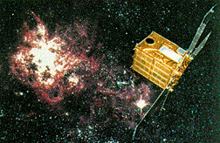Names Astro-C before launch SATCAT no. 17480 Launch date 5 February 1987 | COSPAR ID 1987-012A Launch mass 400 kg (880 lb) Decay date 1 November 1991 | |
 | ||
Similar | ||
ASTRO-C, renamed Ginga (Japanese for 'galaxy'), was an X-ray astronomy satellite launched from the Kagoshima Space Center on 5 February 1987 using M-3SII launch vehicle. The primary instrument for observations was the Large Area Counter (LAC). Ginga was the third Japanese X-ray astronomy mission, following Hakucho and Tenma. Ginga reentered the Earth's atmosphere on 1 November 1991.
Contents
Instruments
Highlights
References
Ginga (satellite) Wikipedia(Text) CC BY-SA
